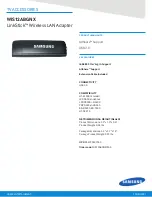
Drawing Number: 21105
Revision: NR
OPERATION MANUAL FOR
BALLISTICS PRESSURE SENSOR CALIBRATION ADAPTOR
FOR AMMUNITION TESTING
Model 090B
2
Insert the empty cartridge case into the chamber
body (Item 1) as shown. Inspect the cartridge
case retainer (Item 3) for an O-ring groove,
which will be found on certain calibrators. If an
O-ring groove is found, an O-ring must be used
with this item. Lubricate O-ring with silicone
grease or equivalent and install on to the
cartridge case retainer (Item 3).
Install the cartridge case retainer (Item 3) and
tighten until its shoulder bottoms snugly against
the chamber body.
2. Slide the retaining nut (Item 4) over chamber
adaptor (Item 2), with the threaded portion first,
facing the o-ring groove. See drawing 090-2 -
90. Install this chamber adaptor/retaining nut
assembly into the test port of a high pressure
hydraulic source (dead weight tester or pressure
pump with reference pressure gage) using
065A06 seal ring. Using the hex flats on the
chamber
adaptor,
tighten
the
chamber
adaptor/retaining nut assembly to approx. 20 ft.
lbs. of torque.
Note: Do not over torque as chamber or seal
could be damaged.
3. Lubricate the O-ring on the chamber adaptor
(Item 2) with silicone grease or hydraulic oil.
Insert the open end of the chamber body (Item 1)
onto the chamber adaptor (Item 2). Insert fully
until end of chamber body meets large diameter
seat on the chamber adaptor.
Thread the retaining nut (Item 4) over the
chamber adaptor, snugly. It will not be necessary
to use large amounts of torque on this nut to
affect a pressure seal.
4. Connect 117B to an electrostatic charge amplifier
(such as PCB Model 462A or 462B52) on "long
time constant".
Zero the system electrically by moving front
panel toggle to "gnd" position momentarily.
5.0
COLLECTING THE DATA
It is important to proceed carefully while performing
the calibration to avoid procedures which could lend
inherent error to the results.
The recommended procedure is as follows:
1.
Allow at least 15 minutes for test equipment to
warm-up and stabilize after connecting sensor to
charge amplifier and charge amplifier to digital
volt meter.
2.
Since the end result of the sensor calibration is a
determination of sensor slope (in units of
picocoulombs/psi) it will be convenient to range
the charge amplifier so that the output charge
can be read directly in picocoulombs.
To facilitate this, choose the 1000 units/volt
range for the miniature versions of the Model
117B (for pressure to 40,000 psi) and 10,000
units/volt for the standard versions (for pressure
to 80,000 psi).
Set the dial gain pot to 10.00 and verify, by
calibration that the transfer function of the
Charge Amplifier is precisely 1000 pC/volt
and/or 10,000 pC/volt.
3.
Set the charge amplifier time constant switch to
"long", switch to "gnd" position and zero the
charge amplifier. Switch to operate and observe
the zero for 15 seconds. No drift should be
observed.
If excessive drift is observed, check for faulty
cable or contamination on connector of sensor.
4.
Apply pressure, increasing to 10,000 psi. Set
pressure precisely, using reference gage and
allow pressure to remain at this level for
approximately 5 seconds. Readjust pressure if
necessary and record voltage reading.
















































